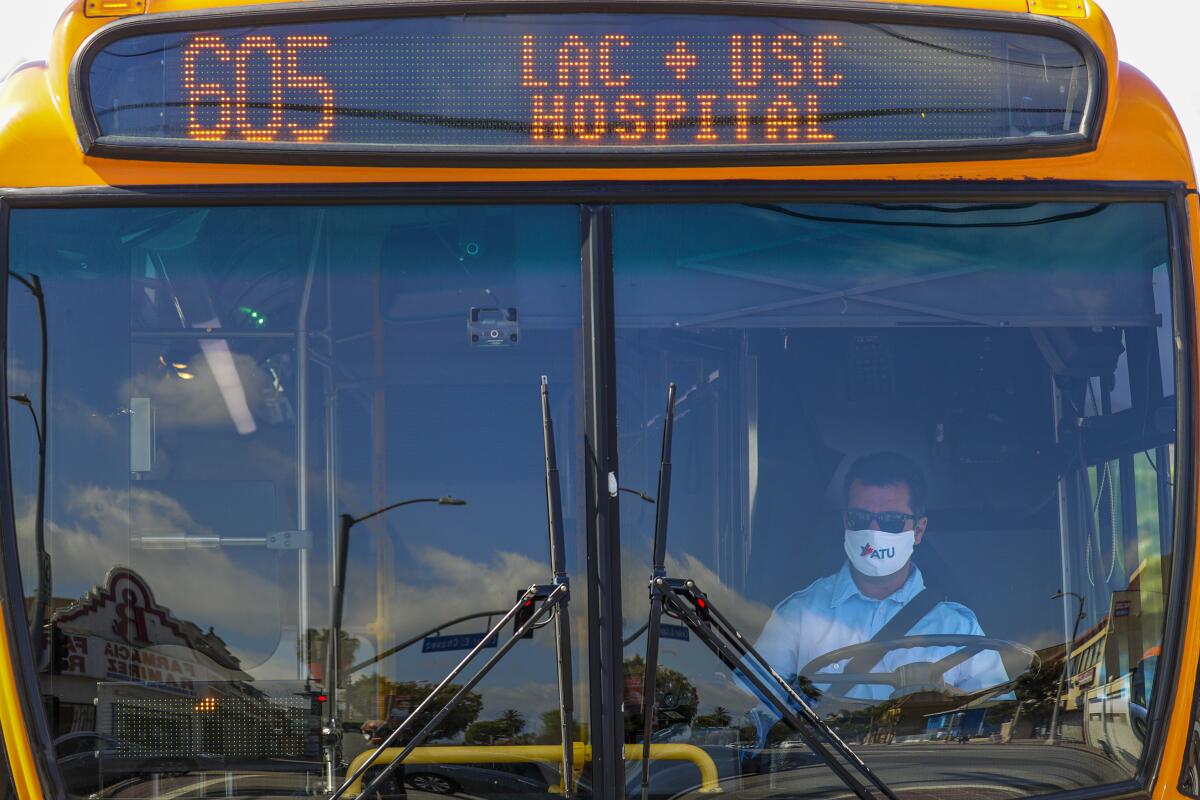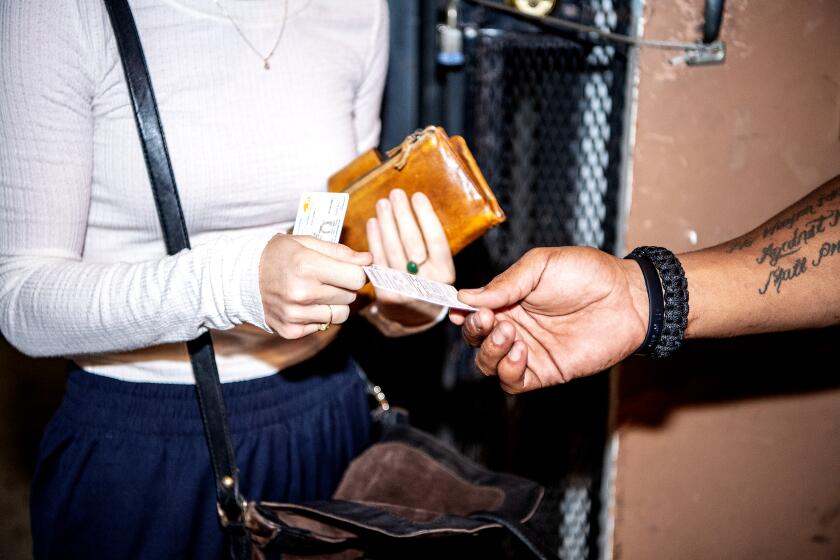Metro slashes bus and rail service amid driver shortage

- Share via
Yolanda Mejia scrolled through her phone as she waited, again, for a late bus on Wednesday at the intersection of Slauson and Vermont avenues in South Los Angeles.
“They come super late,” said Mejia, a 37-year-old cook who relies on buses to get to her job. When they do come, they are full and sometimes pass her by, she said.
She’s not alone. Los Angeles County Metropolitan Transportation Authority bus service has been reduced systemwide by as much as 18% since September as the agency struggles to find enough bus drivers amid the Omicron-fueled COVID-19 surge. At least one heavily used line in South L.A. has seen rides fall by 42% in the last month, Metro said.
Rampant COVID-19 infections among employees, a competitive labor market and a hiring freeze during the pandemic have left the agency without enough drivers and many riders without reliable transportation.
In 2021, through September, reports of violent crimes were up 25% from the same time last year and 9% from 2019, according to L.A. County Metropolitan Transportation Authority data. Some crimes, such as aggravated assaults, are exceeding pre-pandemic levels.
“We’re currently facing a crisis both for our customers and for our employees,” Conan Cheung, who heads Metro bus operations, said at a meeting of the agency’s board on Thursday.
In a bid to stabilize the system, Metro will cut bus service 10% across most lines and reduce rail frequency beginning Feb. 20 in what officials described as an “emergency” measure intended to spread the pain across a system used by about 740,000 people daily.
Metro directors unanimously approved a plan directing Chief Executive Stephanie Wiggins to set a goal for restoring full service by June. She told them she could make no promises.
“I’m here to tell you that today, the goal is not a guarantee,” she said.
The agency runs about 120 bus lines across the county. Buses on the most heavily used lines will arrive weekdays every five to 15 minutes, on average, up from every five to 10 minutes, Metro said. Subway passengers will wait an average of 15 minutes for a train, up from 10; light rail riders will see waits go from eight minutes to 10.
The agency has about 3,400 bus and rail operators but says it needs at least an additional 586 drivers to cover all of its routes.
The Omicron surge has thinned its ranks, with more than 10% of its drivers out sick this week — the highest rate since the pandemic started. Metro officials said 17% of their drivers are unvaccinated but continue to work because of the shortage.
“At 5 in the morning you’re struggling to find people to come in to cover canceled assignments,” Cheung said. “We’re not canceling those because we want to cancel those.”
Part of the problem is that Metro had a hiring freeze for much of the pandemic when it operated on reduced capacity. Metro said at least 3,800 people have applied for operating jobs but only about 1,000 of those applicants remain in the pipeline. It may take more than a month to get them started because they must undergo federal screening.
The problem isn’t unique to Metro, as workers in many fields have quit their jobs and employers offer extra perks to keep them. Metro board Chair Hilda Solis, a former U.S. Labor secretary, said the agency needs to examine its retention efforts for its drivers. They currently start as part-time workers receiving $17.75 per hour. In a six-month pilot program, new drivers will be paid $19.12 an hour and work full time.
Since July, 378 drivers have left the agency. Some retired; others got new jobs or were dismissed for misconduct or poor performance.
L.A. has not cited any businesses for failing to check customers’ COVID vaccination status, opting for a grace period that runs out in a few days.
“We know the system as it exists now really is not sustainable, not for our riders and not for our operators who’ve been through so much during the pandemic,” said Metro board member and Supervisor Holly Mitchell, whose southern L.A. County district has seen significant reductions. Mitchell led the effort to restore service by summer and seek more information about how the cuts have been distributed.
For regular riders like Mejia, the cuts have meant she has shown up a half-hour late to work.
She and 25,000 other passengers rely on an express and local bus line along the Vermont Avenue corridor stretching from Hollywood to South Los Angeles. Mejia won’t ride the bus at night or with her 10-year-old daughter out of safety concerns. The local bus, which makes more frequent stops, has seen service fall 25%, according to Metro. The express has fallen 42%.
Earlier this month, Metro ended a free fare program begun during the pandemic. Mejia couldn’t understand why.
“It should be quicker because now they are charging us,” she said as her bus arrived.
More to Read
Sign up for Essential California
The most important California stories and recommendations in your inbox every morning.
You may occasionally receive promotional content from the Los Angeles Times.













